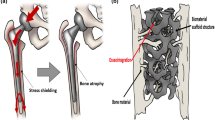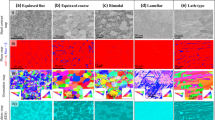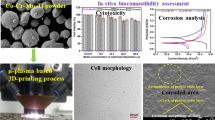Abstract
This paper explores whether additive manufacturing (AM) is more environmentally friendly than conventional manufacturing (CM) for the production of medical implants. The environmental impact of manufacturing the femoral component of a knee implant made from Ti-6Al-4V material was investigated. One AM method (electron beam melting (EBM)) and one CM method (milling) were analysed for the production of this part. A cradle to grave life cycle approach was utilised for each manufacturing method focusing on the primary energy consumption (PEC) and CO2 emissions. It was found that when the entire life cycle of the implant is considered, EBM is a more environmentally friendly method of producing the implant. This is mainly due to the complex geometry of the implant. For complex geometries, lots of waste material are generated using CM processes, whereas much less material is wasted using the AM process. The production of the raw material, Ti-6Al-4V, has a high PEC and associated CO2 emissions, so the amount of required raw material for either manufacturing method is the most important factor from an environmental perspective. Finally, the article presents the plans for future work and some remarks are concluded.










Similar content being viewed by others
References
Thirupathi RM, Vinodh S, Ben Ruben R, Antony J (2019) Application of environmentally conscious manufacturing strategies for an automotive component. Int J Sustain Eng 12(2):95–107. https://doi.org/10.1080/19397038.2018.1508317
Paris H, Mokhtarian H, Coatanéa E, Museau M, Ituarte IF (2016) Comparative environmental impacts of additive and subtractive manufacturing technologies. CIRP Ann 65(1):29–32. https://doi.org/10.1016/j.cirp.2016.04.036
Bours J, Adzima B, Gladwin S, Cabral J, Mau S (2017) Addressing hazardous implications of additive manufacturing: complementing life cycle assessment with a framework for evaluating direct human health and environmental impacts. J Ind Ecol 21(S1):S25–S36
Wu B, Myant C, Weider S (2017) The value of additive manufacturing: future opportunities. Imperial College London, Briefing Paper (2)
Gibson I, Rosen D, Stucker B (2015) Development of additive manufacturing technology. In: Additive manufacturing technologies. Springer, pp 19-42
Kruth J-P, Mercelis P, Vaerenbergh JV, Froyen L, Rombouts M (2005) Binding mechanisms in selective laser sintering and selective laser melting. Rapid Prototyp J 11(1):26–36
Le VT, Paris H (2018) A life cycle assessment-based approach for evaluating the influence of total build height and batch size on the environmental performance of electron beam melting. Int J Adv Manuf Technol 98(1-4):275–288
Narra SP, Mittwede PN, DeVincent WS, Urish KL (2019) Additive manufacturing in total joint arthroplasty. Orthop Clin N Am 50(1):13–20. https://doi.org/10.1016/j.ocl.2018.08.009
Horst A, McDonald F, Hutmacher DW (2019) A clarion call for understanding regulatory processes for additive manufacturing in the health sector. Expert Rev Med Devices 16(5):405–412. https://doi.org/10.1080/17434440.2019.1609353
Gioumouxouzis CI, Karavasili C, Fatouros DG (2019) Recent advances in pharmaceutical dosage forms and devices using additive manufacturing technologies. Drug Discov Today 24(2):636–643. https://doi.org/10.1016/j.drudis.2018.11.019
Tavassoli S, Brandt M, Qian M, Arenius P, Kianian B, Diegel O, Mention A-L, Cole I, Elghitany A, Pope L (2020) Adoption and diffusion of disruptive technologies: the case of additive manufacturing in medical technology industry in Australia. Procedia Manuf 43:18–24. https://doi.org/10.1016/j.promfg.2020.02.103
Rath L (2019) Outlook for joint replacements. Arthritis Foundation News Blog
OECD (2019) Health at a glance 2019: OECD indicators. OECD Publishing, Paris. https://doi.org/10.1787/4dd50c09-en
O’Neill B, Nugent M, Cashman J, O’Flanagan S, Keogh P, Kenny P (2014) The Irish National Joint Registry: where are we now? Ir J Med Sci 183(1):77–83
Hu CY, Yoon T-R (2018) Recent updates for biomaterials used in total hip arthroplasty. Biomater Res 22(1):1–12
Zhang J, Matsuura H, Tsukihashi F (2014) Processes for recycling. In: Treatise on process metallurgy. Elsevier, pp 1507-1561
Huang R, Riddle M, Graziano D, Warren J, Das S, Nimbalkar S, Cresko J, Masanet E (2016) Energy and emissions saving potential of additive manufacturing: the case of lightweight aircraft components. J Clean Prod 135:1559–1570
Priarone PC, Ingarao G, di Lorenzo R, Settineri L (2017) Influence of material-related aspects of additive and subtractive Ti-6Al-4V manufacturing on energy demand and carbon dioxide emissions. J Ind Ecol 21(S1):S191–S202
Liu Z, Jiang Q, Ning F, Kim H, Cong W, Xu C, H-c Z (2018) Investigation of energy requirements and environmental performance for additive manufacturing processes. Sustainability 10(10):3606
Liu Z, Li C, Fang X, Guo Y (2018) Energy consumption in additive manufacturing of metal parts. Procedia Manuf 26:834–845
Faludi J, Bayley C, Bhogal S, Iribarne M (2015) Comparing environmental impacts of additive manufacturing vs traditional machining via life-cycle assessment. Rapid Prototyp J 21(1):14–33
Serres N, Tidu D, Sankare S, Hlawka F (2011) Environmental comparison of MESO-CLAD® process and conventional machining implementing life cycle assessment. J Clean Prod 19(9-10):1117–1124
Kreiger M, Pearce JM (2013) Environmental life cycle analysis of distributed three-dimensional printing and conventional manufacturing of polymer products. ACS Sustain Chem Eng 1(12):1511–1519
Ingarao G, Priarone PC, Deng Y, Paraskevas D (2018) Environmental modelling of aluminium based components manufacturing routes: additive manufacturing versus machining versus forming. J Clean Prod 176:261–275
Campatelli G, Montevecchi F, Venturini G, Ingarao G, Priarone PC (2020) Integrated WAAM-subtractive versus pure subtractive manufacturing approaches: an energy efficiency comparison. Int J Precis Eng Manuf Green Technol 7(1):1–11
Ingarao G, Priarone PC (2020) A comparative assessment of energy demand and life cycle costs for additive- and subtractive-based manufacturing approaches. J Manuf Process 56:1219–1229. https://doi.org/10.1016/j.jmapro.2020.06.009
Rebitzer G, Ekvall T, Frischknecht R, Hunkeler D, Norris G, Rydberg T, Schmidt WP, Suh S, Weidema BP, Pennington DW (2004) Life cycle assessment: Part 1: Framework, goal and scope definition, inventory analysis, and applications. Environ Int 30(5):701–720. https://doi.org/10.1016/j.envint.2003.11.005
Palmer S, Servant C, Maguire J, Parish E, Cross M (2002) Ability to kneel after total knee replacement. J Bone Joint Surg Br Vol 84(2):220–222
Klem N-R, Kent P, Smith A, Dowsey M, Fary R, Schütze R, O’Sullivan P, Choong P, Bunzli S (2020) Satisfaction after total knee replacement for osteoarthritis is usually high, but what are we measuring? A systematic review. Osteoarthr Cartil Open 2(1):100032. https://doi.org/10.1016/j.ocarto.2020.100032
Sharma A (2011) Design of knee prostheis. Negócios, Tecnologia, Lisbon
Welsch G, Boyer R, Collings E (1993) Materials properties handbook: titanium alloys. ASM international
Donachie MJ (2014) A guide to engineering selection of titanium alloys for design. Mechanical Engineers’ Handbook, p 1-37
Bolzoni L (2019) Low-cost Fe-bearing powder metallurgy Ti alloys. Met Powder Rep 74(6):308–313
USGS (2020) Mineral commodity summaries 2020. Mineral Commodity Summaries. Reston, VA. https://doi.org/10.3133/mcs2020
Farjana SH, Huda N, Mahmud MP, Lang C (2018) Towards sustainable TiO2 production: an investigation of environmental impacts of ilmenite and rutile processing routes in Australia. J Clean Prod 196:1016–1025
Habashi F (1997) Handbook of extractive metallurgy. Wily-VCH, Weinheim
Beaman JJ, Felipe Lopez L, Williamson RL (2014) Modeling of the vacuum arc remelting process for estimation and control of the liquid pool profile. J Dyn Syst Meas Control 136(3)
Koshal D (2014) Manufacturing engineer’s reference book. Elsevier. https://doi.org/10.1016/C2009-0-24956-7
Ginta TL, Amin AN (2013) Surface integrity in end milling titanium alloy Ti-6Al-4V under heat assisted machining. Asian J Sci Res 6(3):609–614
Kellens K, Mertens R, Paraskevas D, Dewulf W, Duflou JR (2017) Environmental impact of additive manufacturing processes: does AM contribute to a more sustainable way of part manufacturing? Procedia CIRP 61:582–587
Le Bourhis F, Kerbrat O, Dembinski L, Hascoët J-Y, Mognol P (2014) Predictive model for environmental assessment in additive manufacturing process. Procedia CiRP 15:26–31
Vayre B, Vignat F, Villeneuve F (2012) Metallic additive manufacturing: state-of-the-art review and prospects. Mech Ind 13(2):89–96
Mayyas AT, Qattawi A, Mayyas AR, Omar MA (2012) Life cycle assessment-based selection for a sustainable lightweight body-in-white design. Energy 39(1):412–425
Takeda O, Okabe TH (2019) Current status of titanium recycling and related technologies. JOM 71(6):1981–1990
Mudd GM (2010) The environmental sustainability of mining in Australia: key mega-trends and looming constraints. Res Policy 35(2):98–115
Farjana SH, Huda N, Mahmud MP, Lang C (2019) Life-cycle assessment of solar integrated mining processes: a sustainable future. J Clean Prod:117610
Yoshiki-Gravelsins KS, Toguri JM, Choo RT (1993) Metals production, energy, and the environment, Part I: energy consumption. JOM 45(5):15–20
Forrest D, Szekely J (1991) Global warming and the primary metals industry. JOM 43(12):23–30
Bravard J, Flora H, Portal C (1972) Energy expenditures associated with the production and recycle of metals. Oak Ridge National Laboratory
Gao F, Nie Z, Yang D, Sun B, Liu Y, Gong X, Wang Z (2018) Environmental impacts analysis of titanium sponge production using Kroll process in China. J Clean Prod 174:771–779
Jeswiet J, Kara S (2008) Carbon emissions and CES™ in manufacturing. CIRP Ann 57(1):17–20. https://doi.org/10.1016/j.cirp.2008.03.117
Handy RM (2017) Coal regains top spot in generating electricity in Texas. https://www.houstonchronicle.com/business/article/Coal-regains-top-spot-in-generating-electricity-10946470.php. Accessed 15 Feb 2020
Muller F, Weingarnter E (2008) Vacuum arc melting and remelting process. In: Viswanathan S (ed) Casting. ASM International, pp 132-138
Baumers M, Tuck C, Wildman R, Ashcroft I, Hague R (2017) Shape complexity and process energy consumption in electron beam melting: a case of something for nothing in additive manufacturing? J Ind Ecol 21(S1):S157–S167
Ashby MF (2013) Materials and the environment. Butterworth-Heinemann/Elsevier, Boston
Guo G, Liu Z, An Q, Chen M (2011) Experimental investigation on conventional grinding of Ti-6Al-4V using SiC abrasive. Int J Adv Manuf Technol 57(1-4):135–142
Shaikh V, Boubekri N, Scharf TW (2014) Analyzing the effectiveness of microlubrication using a vegetable oil-based metal working fluid during end milling AISI 1018 steel. Int J Manuf Eng 2014:1–13. https://doi.org/10.1155/2014/261349
Kara S, Li W (2011) Unit process energy consumption models for material removal processes. CIRP Ann 60(1):37–40
Rännar L-E, Glad A, Gustafson C-G (2007) Efficient cooling with tool inserts manufactured by electron beam melting. Rapid Prototyp J 13(3):128–135
Lian Z, Godil A, Rosin PL, Sun X (2012) A new convexity measurement for 3D meshes. In: 2012 IEEE Conference on Computer Vision and Pattern Recognition, 16-21 June 2012. pp 119-126. https://doi.org/10.1109/CVPR.2012.6247666
Sun X, Lian Z (2020) EasyMesh: an efficient method to reconstruct 3D mesh from a single image. Comput Aided Geom Des 80:101862. https://doi.org/10.1016/j.cagd.2020.101862
Fera M, Macchiaroli R, Fruggiero F, Lambiase A (2018) A new perspective for production process analysis using additive manufacturing—complexity vs production volume. Int J Adv Manuf Technol 95(1-4):673–685
Availability of data and material (data transparency)
Not applicable.
Funding
This publication has emanated from research supported in part by a research grant from Science Foundation Ireland (SFI) under Grant Number 16/RC/3872 and is co-funded under the European Regional Development Fund and I-Form industry partners.
Author information
Authors and Affiliations
Corresponding author
Ethics declarations
Conflict of interest
Not applicable.
Code availability (software application or custom code)
Not applicable.
Additional information
Publisher’s note
Springer Nature remains neutral with regard to jurisdictional claims in published maps and institutional affiliations.
Rights and permissions
About this article
Cite this article
Lyons, R., Newell, A., Ghadimi, P. et al. Environmental impacts of conventional and additive manufacturing for the production of Ti-6Al-4V knee implant: a life cycle approach. Int J Adv Manuf Technol 112, 787–801 (2021). https://doi.org/10.1007/s00170-020-06367-7
Received:
Accepted:
Published:
Issue Date:
DOI: https://doi.org/10.1007/s00170-020-06367-7




